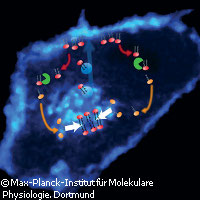Simple process puts proteins in their place
EU-funded scientists have revealed the simple trick that ensures that proteins are correctly distributed within cells. Furthermore, the team demonstrated how their discovery could lead to the development of new treatments for cancer. The research, published in two papers in the journals Cell and Nature, received EU support through a Marie Curie grant. Without a system to control their distribution, proteins would be inclined to spread out evenly throughout the cell. So how do cells ensure that proteins go to where they are needed? A team of researchers led by Herbert Waldmann and Philippe Bastiaens of the Max Planck Institute for Molecular Physiology (MPI) in Germany used state-of-the-art microscopy techniques to track the transport of proteins within living cells in real time. The researchers focused their efforts on proteins that need to get to the outer cell membrane. These proteins are fitted with a fatty acid in a process called 'palmitoylation'; the fatty acid acts like a kind of address label. The study revealed that palmitoylation takes place in a part of the cell called the Golgi apparatus. The palmitoylated proteins are carried to the cell membrane on the surface of tiny vesicles that are pinched off from the Golgi apparatus. However, the interior of the cell is full of different kinds of membranes, and sometimes the palmitoylated proteins do not reach their destination but instead attach themselves to the wrong membranes. When this happens, special enzymes remove the fatty acid from the protein (a processes called 'depalmitoylation'), liberating the protein which then swims freely through the cell. Eventually, the protein is taken up by the Golgi apparatus and the process begins again. This raises the question of how the Golgi apparatus recognises proteins that need to go to the cell membrane. The answer is surprisingly simple. At a basic level, proteins are made up of chains of building blocks called amino acids. If a protein has the amino acid cysteine accessible on its surface, it is given a fatty acid address label. 'These findings represent a milestone. They will change the way research in cellular biology is done,' commented Professor Bastiaens. 'It's only when we as scientists understand the principles by which life works that we are truly able to understand life. Focussing on the many different signalling pathways within the cell doesn't really help that much.' In addition, the team has already demonstrated how its findings could be applied to the search for new cancer treatments. The signalling molecule Ras is a palmitoylated protein which, when mutated, can cause cancer. Ras only works when it is embedded in the cell membrane. Switching Ras off completely causes even healthy cells to die, so the researchers took a different approach. As noted above, sometimes all palmitoylated proteins, including Ras, become attached to the wrong membranes. When Ras attaches itself to the wrong membrane, an enzyme called APT1 (acyl protein thioesterase 1) cuts off the lipid marker and frees Ras, allowing it to get back into the transport system. The researchers created an inhibitor molecule called palmostatin B that blocks the action of APT1. This means that when Ras lands on the wrong membrane, it is effectively stuck there. Over time, Ras molecules become randomly distributed throughout the different membranes of the cell. As Ras is only truly harmful when it is attached to the cell's outer membrane, redistributing the proteins in this way reduces Ras signalling and causes cancerous cells to start a journey back to health. 'This was a brand new approach - and it actually goes against common sense. That's why it was never taken any further in pharmaceutical research,' explained Professor Waldmann. 'What we did was this: instead of inhibiting directed transportation from the Golgi apparatus, we promoted random distribution within the cell.'
Countries
Germany



